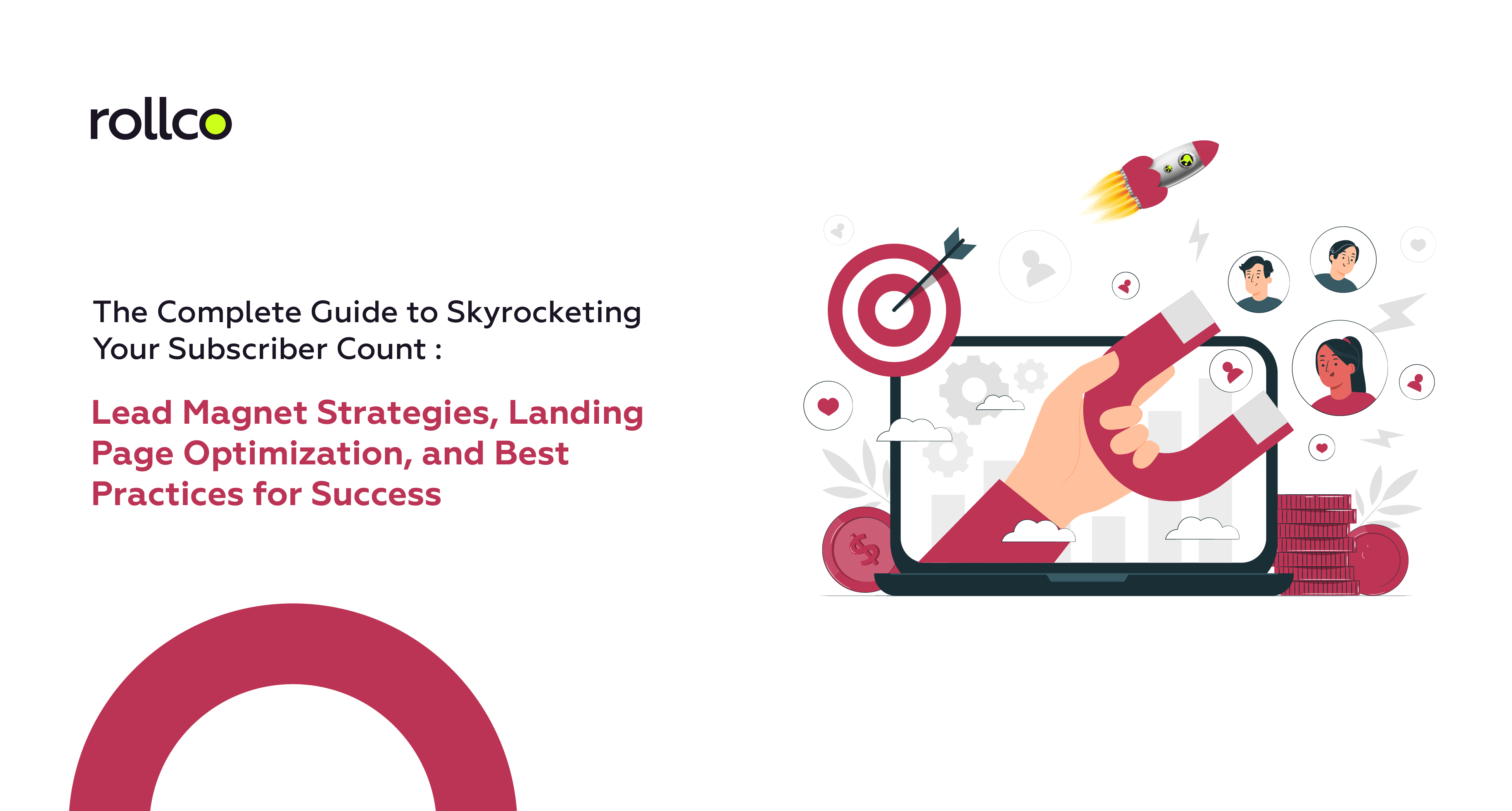Are you seeking to expand your reach, attract potential customers, and transform them into loyal followers? What if we introduced you to a potent marketing strategy capable of propelling your business to new heights? Prepare to embark on a journey into the world of lead magnets and Landing Page Optimization—an incredibly powerful method, not only for building but also for nurturing your email list.
Welcome to The Complete Guide to Skyrocketing Your Subscriber Count: Lead Magnet Strategies, Landing Page Optimization, and Best Practices for Success. In this comprehensive guide, we’re about to unravel the secrets of creating irresistible lead magnets that will leave your audience utterly captivated, transforming them into fervent advocates of your brand.
Let’s embark on this transformative journey and equip you with the knowledge and tools you need to skyrocket your subscriber count and realize unparalleled success in the world of digital marketing.
What is Lead Magnet?
A lead magnet is a valuable resource or incentive offered by businesses to potential customers in exchange for their contact information, usually in the form of an email address. The primary purpose of a lead magnet is twofold: it helps in building an extensive email list, and it plays a crucial role in establishing trust between consumers and businesses.
In today’s fiercely competitive marketplace, simply asking visitors to sign up for newsletters is no longer sufficient. Consumers have grown more cautious about sharing their personal information online. They now demand genuine value and relevance before they are willing to engage with an offer. This is precisely where effective lead magnet funnels come into play. They provide compelling resources that cater directly to the specific needs and challenges of prospective clients.
An effective lead magnet funnel should be informative, concise, and presented in easily digestible formats, such as PDFs or videos. These resources are tailored to address the pain points of your target audience, guiding them further along the sales funnel toward conversion. A well-crafted lead magnet not only grows your subscriber count but also sparks interest among potential customers, laying a solid foundation for future interactions and fostering enduring relationships. Lead magnets are an indispensable tool in modern marketing, bridging the gap between businesses and their audiences by delivering value and building trust.
What is a Lead Magnet Strategy?
A lead magnet strategy is a focused plan to attract potential customers and capture their contact information by offering something of value in return. This strategy typically involves the following components:
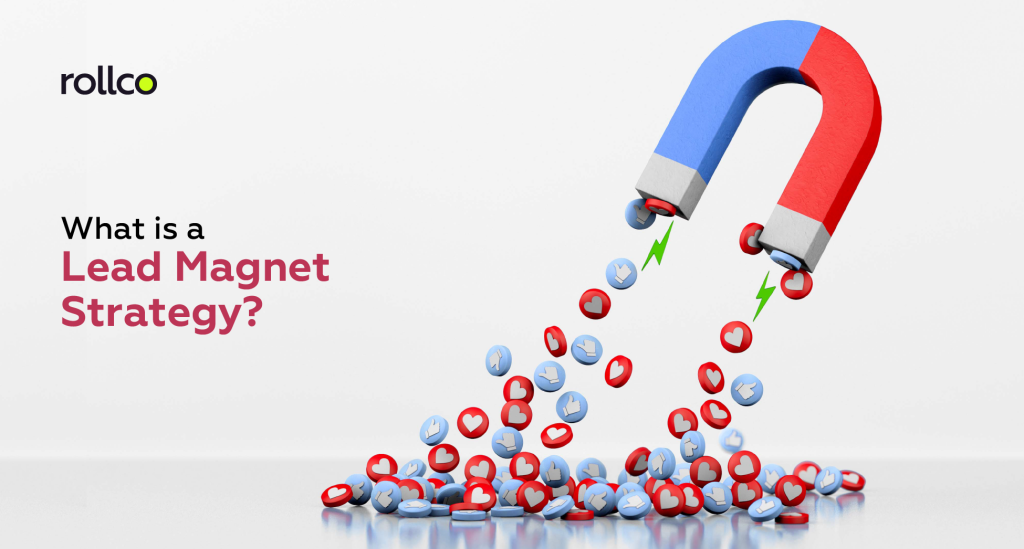
- Audience Targeting: Identifying and understanding the specific audience you want to reach.
- Value Proposition: Creating a compelling offer or resource that addresses the audience’s needs or challenges.
- Content Creation: Developing the lead magnet content, which can be in the form of ebooks, guides, webinars, or other valuable assets.
- Landing Page Design: Designing an effective landing page to showcase the lead magnet and capture contact details.
- Promotion and Distribution: Promoting the lead magnet through various channels like social media, email marketing, and content marketing.
- Data Collection and Nurturing: Collecting and managing leads, and nurturing them through subsequent marketing efforts.
The goal of a lead magnet strategy is to build an email list, establish trust, and ultimately convert leads into customers.
What Are The 10 Best Lead Magnet Strategies In The World?
These 10 lead magnet strategies are effective tools for drawing in potential customers. From ebooks to exclusive discounts and interactive quizzes, they provide strong incentives for collecting contact information and nurturing customer relationships.
Ebooks and Guides:
Create in-depth, informative ebooks or guides that address a specific pain point or challenge your target audience faces.
Checklists and Cheat Sheets:
Offer concise and actionable checklists or cheat sheets that provide quick solutions or step-by-step instructions.
Webinars and Online Workshops:
Host live or on-demand webinars or workshops on topics of interest to your audience, encouraging them to register with their email addresses.
Templates and Tools:
Share templates, calculators, or tools that simplify complex tasks or calculations, making life easier for your audience.
Exclusive Discounts and Promotions:
Provide exclusive discounts or promotional codes for your products or services, enticing potential customers with savings.
Content Upgrades:
Enhance the value of your blog posts or articles by offering content upgrades like bonus chapters, resource lists, or additional insights in exchange for email sign-ups.
Email Courses:
Offer a multi-day email course that educates subscribers on a specific subject, delivered directly to their inbox.
Quizzes and Assessments:
Create interactive quizzes or assessments that provide personalized recommendations, requiring email sign-up to receive results.
Free Trials and Demos:
Let potential customers experience your product or service with a free trial or demo in exchange for their contact information.
Resource Libraries:
Build a valuable resource library or content hub, where users can access a wealth of informative content by signing up with their email addresses.
These lead magnet strategies are versatile and can be tailored to suit your target audience’s preferences and your business’s goals. The key is to offer valuable, relevant content that addresses your audience’s needs and provides a clear incentive for them to share their email addresses.
What Are The 5 Key Areas Important For A Great Lead Magnet?
- Relevance: Tailor your lead magnet to be directly relevant to your target audience or a specific segment within it.
- Value: Offer substantial value that justifies users sharing their contact information. Provide unique insights or solutions that can’t easily be found elsewhere.
- Trustworthiness: Establish credibility by supporting your content with data and research. Ensure that your materials are well-written and error-free.
- Leaving Them Wanting More: Strike a balance between satisfying your audience’s needs and leaving them intrigued for further engagement. Avoid giving away everything for free while still offering value.
- Shareability: Make your lead magnet easily shareable to extend your reach through word-of-mouth promotion.
How Do I Get Traffic To My Lead Magnet?
Getting traffic to your lead magnet is crucial for successful lead generation. Here are some key strategies:
- Content Promotion: Use your blog, social media, and email marketing to promote your lead magnet. Create relevant, engaging content around it.
- SEO Optimization: Optimize your content for search engines with relevant keywords and meta descriptions.
- Guest Blogging: Contribute guest posts to authoritative websites in your niche with links to your lead magnet.
- Paid Advertising: Invest in paid ads on platforms like Google Ads, Facebook, or LinkedIn to target your audience directly.
- Social Media Promotion: Share your lead magnet on various social media platforms, utilizing targeted ads for maximum exposure.
- Email Marketing: Promote your lead magnet to your existing email list and encourage them to share it.
- Networking: Engage with industry influencers and communities to help spread the word about your lead magnet.
By utilizing these strategies, you can drive valuable traffic to your lead magnet and expand your subscriber base.
What is a Good Example of a Lead Magnet?
A good example of a lead magnet is one that provides valuable and relevant content, solving a specific problem or fulfilling a need for your target audience. Here’s what makes a lead magnet effective:
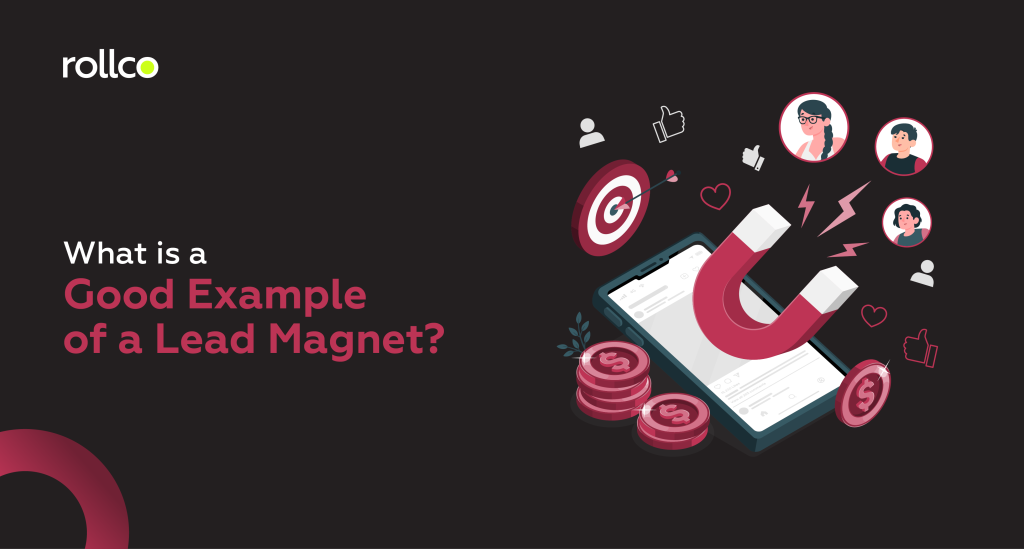
- Relevance: It directly aligns with the audience’s interests and pain points.
- Value: It offers valuable insights, information, or tools not easily found elsewhere.
- Simplicity: It’s easy to consume, such as a checklist, template, or short guide.
- Solves a Problem: It addresses a common challenge or provides a solution.
- Clear Benefit: It clearly communicates the benefits users will receive.
- Quick Access: It provides immediate access in exchange for contact information.
What is Landing Page Optimization?
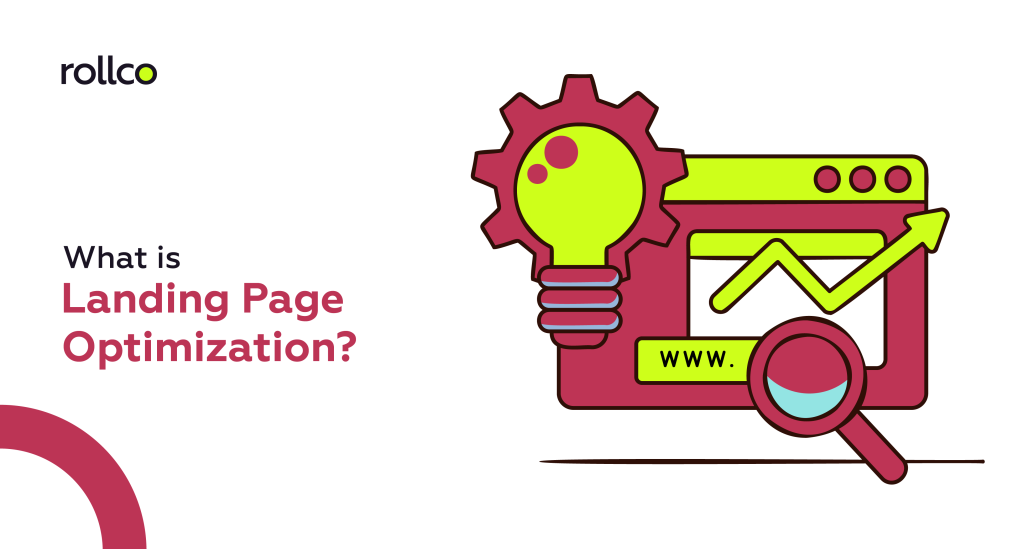
Landing Page Optimization (LPO) is the process of refining and enhancing elements on a website to maximize conversions. It’s a pivotal subset of Conversion Rate Optimization (CRO), and it employs methods such as A/B testing to enhance the conversion goals of a specific landing page.
Why Landing Page Optimization Matters For Your Online Business?
Landing pages serve as the linchpin of your online marketing campaigns. They are meticulously designed to generate sales, capture leads, or achieve other predefined objectives. Often, landing pages act as the primary destination for paid online marketing campaigns, making them central to the allocation of considerable financial and resource investments.
Given that landing pages are fundamentally oriented towards conversions, improving their performance can lead to substantial enhancements in your business outcomes. This is precisely where Landing Page Optimization comes into play.
By optimizing a landing page, you ensure that you achieve the highest possible conversion rate from the visitors who arrive at that landing page. In effect, LPO can help you reduce customer acquisition costs, increase the volume of customers, and maximize the return on your advertising investments.
How To Get Started With Landing Page Optimization?
Embarking on your journey into Landing Page Optimization involves considering two fundamental aspects: optimizing different traffic sources and manipulating on-page elements.
Optimizing for Different Traffic Sources: Not all website traffic is created equal. Visitors who land on your page through paid search ads (e.g., Google AdWords) may behave differently compared to those originating from social media ad campaigns. Tailoring your landing page to match the unique characteristics of each traffic source is essential for success.
Playing Around with On-Page Elements: This is where you can apply commonly discussed landing page optimization techniques. Experiment with various elements, such as testing different value propositions, altering form fields, and incorporating more social proof. By tweaking these on-page components, you can fine-tune your landing page for optimal conversions.
The Benefits of Optimizing Your Landing Page
Optimizing your landing page is not just a marketing tactic; it’s a strategic move that can yield an array of benefits for both marketers and the audience they seek to engage. The real magic happens when you fine-tune your landing page to be more efficient and engaging. By implementing actionable landing page best practices, you open the gateway for individuals who are not just curious but genuinely interested in what your product, app, or offer can do for them. This approach leads to several noteworthy advantages.
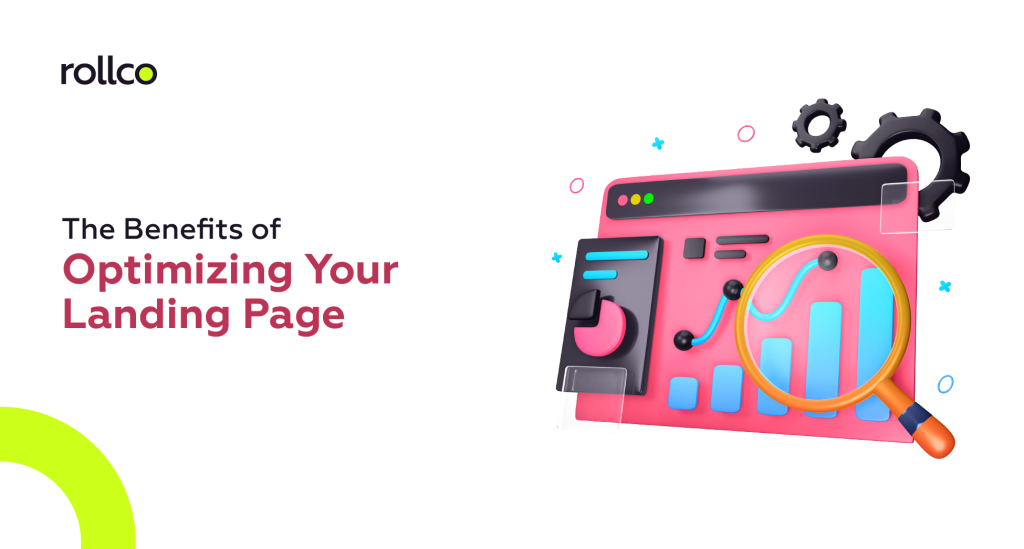
First and foremost, it enhances the user experience. When your landing pages are optimized to provide relevant, well-structured content and meaningful interactions, it creates a more satisfying and delightful journey for your visitors. This, in turn, keeps them engaged, ultimately strengthening their connection to your brand.
Moreover, landing page optimization has a direct impact on conversion rates. Whether you’re aiming for e-commerce sales or lead generation, LPO ensures you’re extracting the maximum possible value from the visitors who land on that page. You’re not just attracting clicks; you’re guiding those clicks toward the actions that matter most.
Additionally, the benefits extend to your bottom line. Landing page optimization is an effective tool for reducing customer acquisition costs. By offering more value to targeted visitors and optimizing the overall user experience, you’re not only attracting more of the right audience but also doing so at a lower cost per click. In this way, LPO becomes a key driver in decreasing your overall customer acquisition costs.
10 Best Tips for Landing Page Optimization
Certainly, here are 10 of the best tips for landing page optimization to help you maximize conversions and achieve your marketing goals:
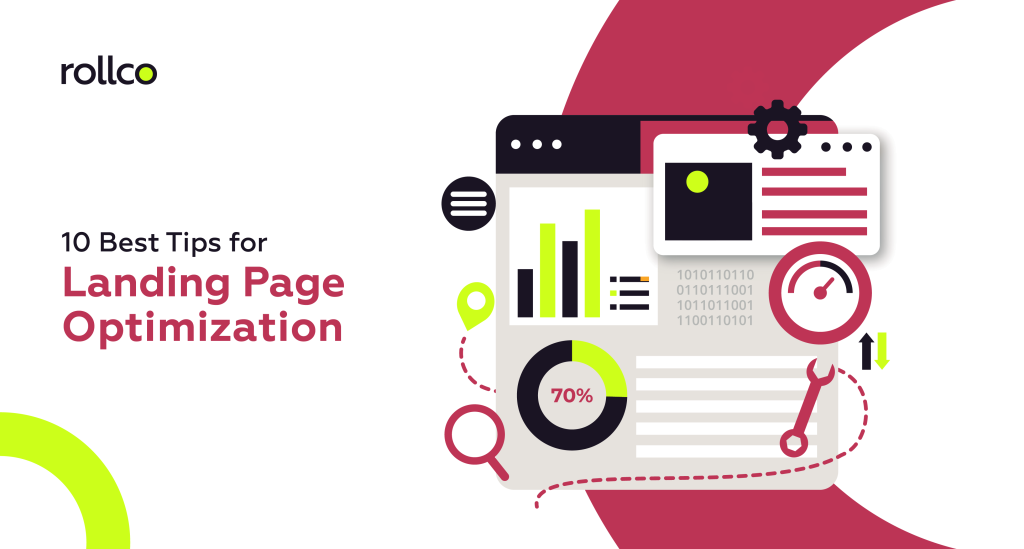
Clear and Compelling Headline:
Craft a concise and attention-grabbing headline that clearly communicates the value proposition of your offer. Make it compelling and relevant to the visitor’s needs or interests.
Strong Call-to-Action (CTA):
Your CTA button should stand out with a contrasting color, and the text should be action-oriented. Use phrases like Get Started, Download Now, or Subscribe.
Minimalist Design:
Keep the design clean and uncluttered. Remove unnecessary distractions and focus on the primary goal of the page. Use high-quality images or visuals that support your message.
Mobile Optimization:
Ensure your landing page is fully responsive and looks great on all devices. With the increasing use of mobile devices, this is crucial for a positive user experience.
Form Optimization:
If you’re collecting lead information, only ask for the essential details. Long forms can deter visitors. A/B test different form lengths to find the sweet spot.
Compelling Copy:
Write persuasive and concise copy that highlights the benefits of your offer. Use bullet points, subheadings, and clear language to make the content scannable.
Social Proof:
Incorporate testimonials, reviews, and trust signals to build credibility and trust. Showcase endorsements from satisfied customers or relevant industry authorities.
A/B Testing:
Continuously test different elements of your landing page, including headlines, CTAs, images, and forms. A/B testing helps identify what resonates best with your audience.
Loading Speed:
Optimize your page for quick loading times. Slow pages can result in high bounce rates. Compress images and minimize server requests to improve speed.
Analytics and Tracking:
Implement tracking tools like Google Analytics to monitor visitor behavior. Analyze user data to gain insights and make informed decisions for ongoing optimization.
Remember that the key to effective landing page optimization is ongoing testing and refinement. Regularly analyze your landing page’s performance, make data-driven changes, and keep improving to achieve the best results.
What Are The Best Practices For Lead Magnet And Landing Page Optimization?
Optimizing your lead magnet and landing page is pivotal for successful conversion and audience engagement. These best practices ensure that you not only capture visitors’ attention but also guide them seamlessly toward your desired actions. Here are the key strategies to master:
- Alignment: Ensure that your lead magnet directly aligns with your landing page’s content, providing a seamless and relevant user experience.
- Clarity: Craft clear and compelling headlines and copy that convey the value of your lead magnet and what visitors can expect.
- Simplicity: Keep your landing page design uncluttered and easy to navigate, guiding visitors toward your call to action.
- Form Optimization: Create concise and user-friendly forms for capturing lead information, asking for only essential details.
- Mobile Responsiveness: Ensure that your landing page is fully responsive and functional on various devices.
- A/B Testing: Continuously test different elements to improve performance, such as headlines, visuals, and CTAs.
- Trust Signals: Use trust-building elements like testimonials, trust seals, and data security assurances.
- Engaging Content: Develop engaging content on your landing page, and consider using multimedia like videos and images to enhance it.
- Data-Driven Decisions: Analyze visitor behavior and conversion data to make informed optimization decisions.
- Loading Speed: Optimize your landing page for fast loading times, reducing bounce rates and improving user experience.
These practices collectively create a strategic roadmap for elevating your lead generation and conversion efforts, cementing your path to successful online engagement and growth.
Conclusion
With this complete guide, you’re well on your way to skyrocketing your subscriber count. By implementing lead magnet strategies, optimizing landing pages, and adhering to best practices, you’ll not only increase your subscriber base but also enhance your overall digital marketing efforts. So, get ready to watch your subscriber count soar as you put these strategies into action!

